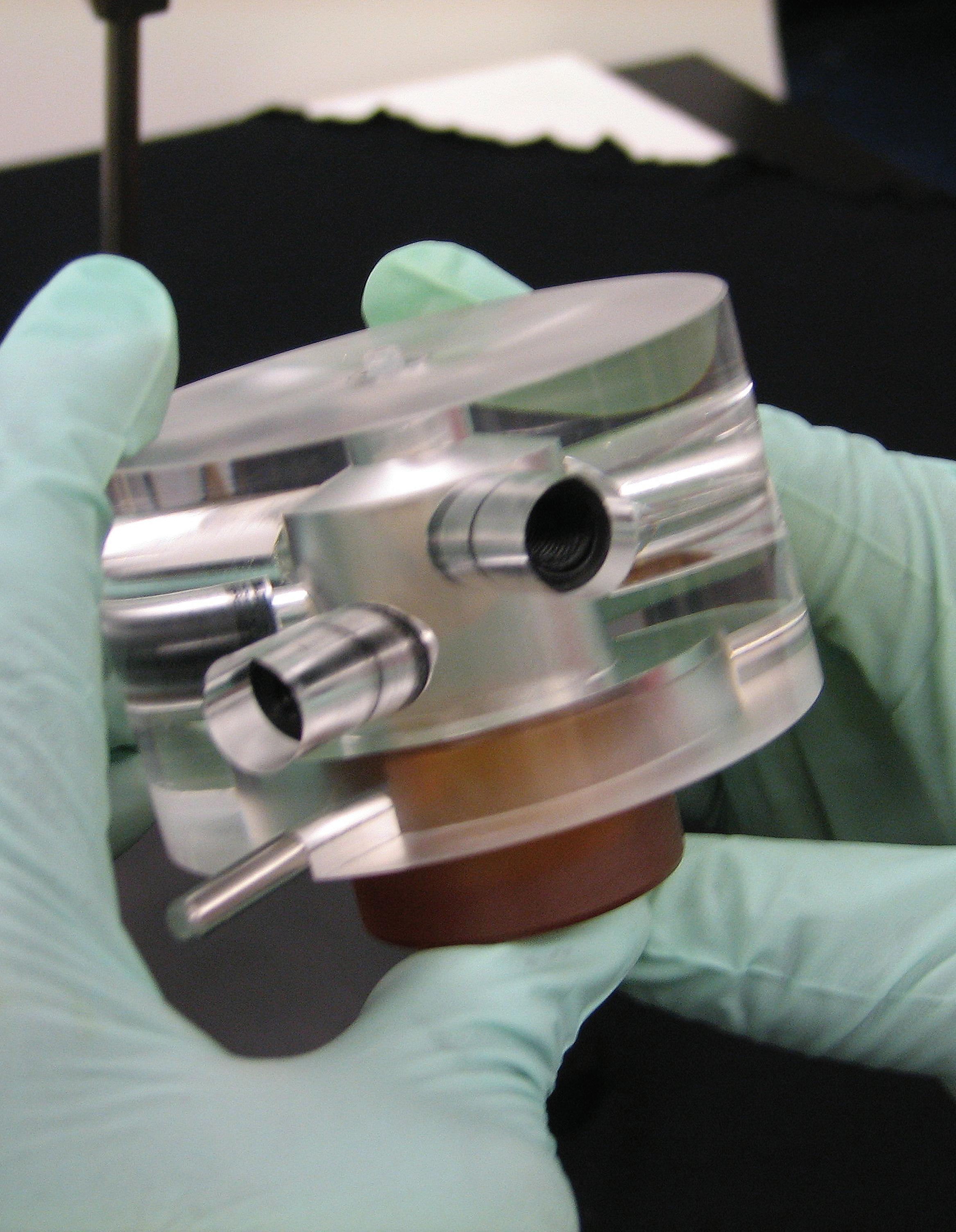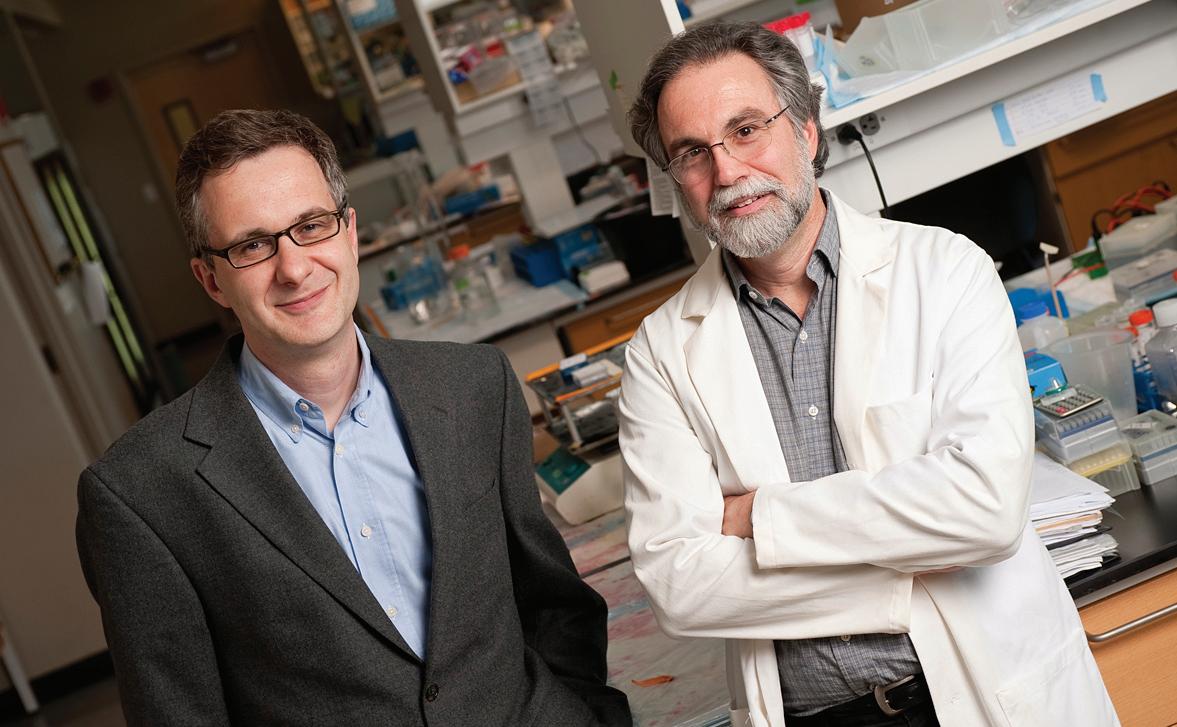
5 minute read
Artificial Cilia
Naturally inspired: Nanoparticles Self-assemble Into artificial Cilia
By Mary SpIro
Advertisement
Bacteria flick long tails, called flagella, to get around. Cells that line your lungs, stomach and that help you hear wave their cilia to push fluids and molecules across their surfaces. Now, scientists at the Johns Hopkins Applied Physics Laboratory (APL) and the University of Arizona want to mimic these naturally occurring structures and motions to create a synthetic version, built from just a few nanoparticles. Researchers hope these biomimetic cantilevers and swimmers will be used as microsensors in devices that detect biological agents, identify voices and even swim through the body to deliver drugs.
Jason Benkoski, a senior scientist at APL and an affiliated faculty member of Johns Hopkins Institute for NanoBioTechnology, has been taking nanospheres of cobalt and magnetite, applying magnetic forces and creating self-assembling artificial cilia and flagella that undulate and wave much like the real thing.
“It’s the simplest kind of actuator,” Benkoski said. “We can envision this being used in fluid transport, locomotion, acoustic detection, and transferring mechanical energy into electrical energy.”
In a fluid filled environment and supported by a silicon wafer, the filaments are built up, nanosphere-bynanosphere, much like adding beads to a string. However, no string holds the 25 nanometer diameter beads together. Instead, they order, self assemble and cling together via magnetic attraction. Even when the magnetic force fields are removed, the artificial cilia remain intact. Because of this construction, the fabricated cilia are thin, long and flexible.
“A single filament can be as many as 2000 particles in length but just one particle in diameter,” Benkoski said.
Benkoski said the need for such a material developed from the fact that “even though microchip and microsensor technologies were advancing rapidly, the technology for mechanical actuators associated with them lagged far behind. It limited what you could do.”
Working with Jeffrey Pyun and colleagues at the University of Arizona, the APL group used a cobalt particle with thin polymer coating to construct the cilia. They next applied a magnetic field to the solution of particles, which helped draw and align the particles into continuous linear structures. “But even before we applied the magnetic field we noticed that the particles were starting to form chains,” he said. Benkoski also said the manner in which the artificial cilia self assembled mimicked the way that actin fibers grow in cells.
The fibers wave and swipe in response to applied magnetic fields. Benkoski said technology like this could be developed into nanoscale “windshield wipers” for self-cleaning surfaces or micropumps to produce flow in microfluidic devices.
Beyond the construction of artificial cilia, Benkoski’s group also has fabricated a structure resembling a bacterium with a flagellum—or tail. These “artificial swimmers” are made of a larger 250 nm diameter head made of superparamagnetic magnetite with an attached 25 nanometer diameter ferromagnetic cobalt tail several micrometers in length.
Like the cilia, the flagellum of this fabricated bacteria bend and flip much like the real thing, albeit in response to a magnetic pulse. Movies of the devices show how easily they propel themselves through fluid. “Like E. coli, they don’t use much energy to get around,” Benkoski said.
Although nanotools like the artificial cilia and swimmers are likely decades away from being used in living organisms, applications for devices like sensors probably are not that far off. Benkoski said. “You could make them out of any material as long as it was magnetic and biologically compatible.” ®
For further reading: Dipolar assembly of ferromagnetic nanoparticles into magnetically driven artificial cilia. Jason J. Benkoski, Ryan M. Deacon, H. Bruce Land, Lance M. Mixtures of 250 nm magnetite (red) and 25 nm cobalt (grey) nanoparticles organize into flagella-like assemblies. The “head” plus “tail” structures flick back and forth under the influence of an alternating magnetic field to swim much like Baird, Jennifer L. Breidenich, Rengaswamy Srinivasan, Guy V. Clatterbaugh, Pei Yuin Keng and Jeffrey Pyun. Soft Matter, 2010, 6, 602-609 spermatozoa. Images: JHUAPL
Be remarkable.
And maximize your unique perspective alongside today’s most brilliant minds. Your individuality makes you a valuable team member here. Because shaping some of the world’s most critical technologies is a highly collaborative endeavor.

The Advanced Technologies, Advanced Materials Group at BAE Systems is focused on developing technology solutions in chemical and biological sensing and detection, alternative power and energy, and imaging. Located at the Steiff Silver building near the Homewood campus of JHU and in Columbia, MD, the group consists of senior scientists from venerable institutions like MIT, Harvard, NIH, NIST amongst others and offer a gold mine of learning opportunities. Our scientists come from a variety of disciplines; chemistry, biology, materials science, physics and electrical engineering and have a range of expertise from nanomaterials to laser systems. At BAE Systems, we are looking for outstanding research engineers and scientists across a broad range of disciplines, especially those who have been cross trained in institutes like the INBT and can work in multi-disciplinary areas involving chemistry, physics, biology, and other areas of science. Common qualities required in each discipline are a complete and thorough understanding of the fi eld, the ability to confi dently address a broad range of research questions, the ability to work effectively in small interdisciplinary teams, and excellent interpersonal and communications skills. For senior positions, a track record of success in research and development, and experience working with customers to defi ne and execute research programs are also required. We are always interested in increasing the depth and breadth of our group! With more than 100 new inventions every year from a global workforce of 100,000+ highly skilled people and 2008 sales of $34.4 billion, BAE Systems is the 3rd largest global defense company to offer unprecedented opportunities worldwide.
Applicants selected may be subject to a security investigation and must meet eligibility requirements for access to classifi ed information. U.S. citizenship is required. BAE Systems offers excellent benefi ts. For detailed information and for a full listing of all opportunities, please visit our Web site at www.baesystems.jobs EOE, M/F/D/V.










